Micromeritics's ASAP2405 report explained (AWM)
original text
explanations
comments
Device: ASAP2405 - 6-channel automatic sorption analyzer, (Micromeritics Corp., USA)
Sample: experimental active carbon RIB (Norit BV, Netherlands)
Adsorbate: N2 at 78K
In this measurement/report:
Relative pressure range: 0.05 - 0.99
Analyses: adsorption/desorption isotherms,
BET and Langmuir specific surface area
t-plot (Harkins-Jura equation)
BJH (Barret-Joyner-Halenda) surface/volume mesopore analysis (adsorption/desorption)
All Figures are drawn according to the reported isotherm data by me (AWM).
Micromeritics Instrument Corporation
ASAP 2405N V1.01 ADSORBATE: NITROGEN PAGE 1
SAMPLE DIRECTORY/NUMBER: DATA1 /142 START 08:37:51 06/26/98
SAMPLE ID: R/B COMPL 19:41:49 06/26/98
SUBMITTER: REPRT 09:35:18 06/29/98
OPERATOR: SAMPLE WT: 1.1288 g
STATION NUMBER: 3 EQUIL INTERVAL: 5 sec FREE SPACE: 97.4868 cc
ANALYSIS LOG
RELATIVE PRESSURE VOL ADSORBED ELAPSED TIME SATURATION
PRESSURE (mmHg) (cc/g STP) (HR:MN) PRESS.(mmHg)
x=p/ps p Va time ps
 3:02 751.057
3:02 751.057
0.0587 44.071 314.2087 3:27
0.0792 59.454 323.3588 3:47
0.1324 99.427 337.2521 4:07
0.1441 108.249 339.3304 4:16
0.1673 125.636 342.7346 4:26
0.2003 150.418 346.7142 4:37
0.2483 186.494 351.5293 4:48
0.3459 259.759 359.5118 5:01 ◄◄◄ p/ps≈0.4 - hysteresis loop
5:03 750.953
0.4457 334.689 366.2021 5:13
0.5572 418.388 373.2755 5:27
0.6436 483.263 379.0942 5:37
0.7470 560.855 387.4077 5:54
0.7969 598.292 391.7355 6:02
0.8348 626.691 395.1406 6:09
0.8701 653.209 398.2824 6:17
0.9019 677.018 400.7671 6:23
0.9198 690.459 402.3520 6:28
0.9364 702.939 404.1616 6:33
0.9500 713.115 406.0604 6:39
0.9619 722.018 408.0504 6:44
0.9689 727.219 409.6730 6:48
0.9757 732.356 411.6911 6:53
0.9812 736.465 413.5470 6:5716 ◄◄◄ Vt=V(p/ps≈0.98)
0.9835 738.199 414.6281 7:01
7:05 750.540
0.9878 741.345 416.8401 7:06
0.9892 742.436 418.0067 7:10
====== 0.9947 ==== 746.546 ===== 420.8760 ======= 7:16 <=============== ◄◄◄ p close to ps
 0.9810 736.272 419.6332 7:19
0.9810 736.272 419.6332 7:19
0.9719 729.402 418.1166 7:23
0.9643 723.688 416.7538 7:27
0.9643 723.688 416.5946 7:28
0.9534 715.483 414.5608 7:34
0.9380 703.899 412.4948 7:40
0.9296 697.563 411.3706 7:44
0.9031 677.722 409.2945 7:50
0.8642 648.473 407.3190 7:57
0.8286 621.755 405.7912 8:04
0.8027 602.331 404.9170 8:08
0.7285 546.619 402.5403 8:16
0.6567 492.754 400.3286 8:23
0.5546 416.080 396.8762 8:33
9:07 750.178
0.4544 340.847 370.4437 9:29 ◄◄◄ p/ps≈0.4 - hysteresis loop
0.3507 263.102 360.4513 9:44
0.2492 186.944 352.1268 9:58
0.2003 150.288 347.0935 10:10
0.1536 115.191 341.1276 10:23
0.1018 76.394 330.9598 10:41
0.0517 38.814 310.9733 11:05

Adsorption/desorption isotherm of N2 on active carbon RIB (Norit), T=78K
Micromeritics Instrument Corporation
ASAP 2405N V1.01 ADSORBATE: NITROGEN PAGE 4
SAMPLE DIRECTORY/NUMBER: DATA1 /142 START 08:37:51 06/26/98
SAMPLE ID: R/B COMPL 19:41:49 06/26/98
SUBMITTER: REPRT 09:35:18 06/29/98
OPERATOR: SAMPLE WT: 1.1288 g
STATION NUMBER: 3 EQUIL INTERVAL: 5 sec FREE SPACE: 97.4868 cc
BET SURFACE AREA REPORT
BET SURFACE AREA: 1190.1411 +/- 26.5809 sq. m/g
SLOPE: 0.003682 +/- 0.000081
Y-INTERCEPT: -0.000025 +/- 0.000011
C: -148.159561
VM: 273.394623 cc/g STP
CORRELATION COEFFICIENT: 9.99276E-01
RELATIVE VOL ADSORBED 1/
PRESSURE (cc/g STP) [VA(Po/P - 1)]
x=p/ps Va yBET=1/[Va(1/x – 1)
0.0587 314.2087 0.000198
0.0792 323.3588 0.000266
0.1324 337.2521 0.000452
0.1673 342.7346 0.000586
0.2003 346.7142 0.000722
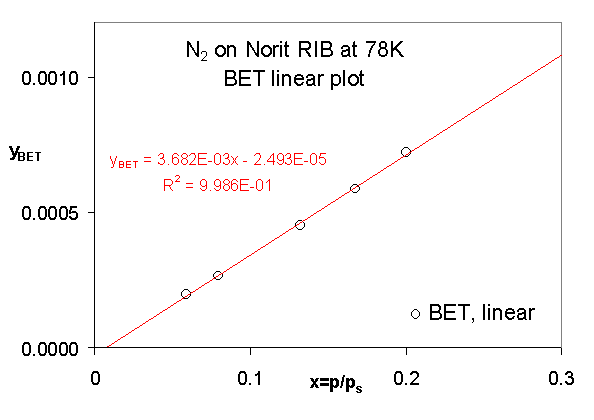
Adsorption isotherm of N2 on active carbon RIB (Norit), T=78K – linear form of BET equation
This method gives reliable results for solids that do not contain large amount of micropores or supermicropores and mesopores are rather large, i.e. surface of the solid may be well approximated by the flat surface. SBET[m2/g] = 4.35·Va,BET[cc/g STP] – determined from the linear plot.
Micromeritics Instrument Corporation
ASAP 2405N V1.01 ADSORBATE: NITROGEN PAGE 6
SAMPLE DIRECTORY/NUMBER: DATA1 /142 START 08:37:51 06/26/98
SAMPLE ID: R/B COMPL 19:41:49 06/26/98
SUBMITTER: REPRT 09:35:18 06/29/98
OPERATOR: SAMPLE WT: 1.1288 g
STATION NUMBER: 3 EQUIL INTERVAL: 5 sec FREE SPACE: 97.4868 cc
LANGMUIR SURFACE AREA REPORT
LANGMUIR SURFACE AREA: 1576.9810 +/- 5.7505 sq. m/g
SLOPE: 0.002760 +/- 0.000010
Y-INTERCEPT: 0.000026 +/- 0.000001
b: 0.009364
VM: 362.257965 cc/g STP
CORRELATION COEFFICIENT: 9.99980E-01
RELATIVE VOL ADSORBED 1/
PRESSURE (cc/g STP) [VA*Po/P]
x=p/ps Va yL=1/[Va/x]
0.0587 314.2087 0.000187
0.0792 323.3588 0.000245
0.1324 337.2521 0.000393
0.1673 342.7346 0.000488
0.2003 346.7142 0.000578
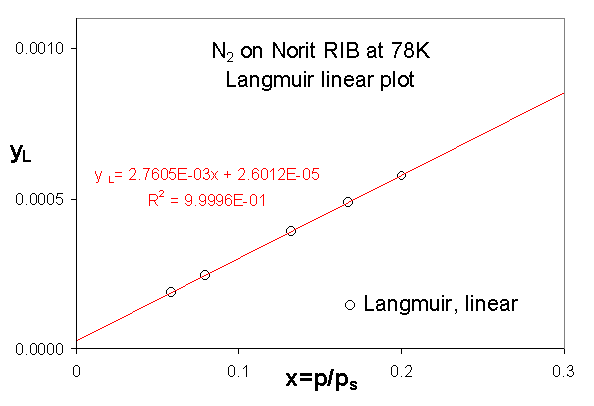
Adsorption isotherm of N2 on active carbon RIB (Norit), T=78K – linear form of Langmuir equation
(This method gives
results that are applicable for strongly microporous solids, having only small
share of mesopores. Though Langmuir model has nothing to do with micropores, it
approximates well enough the course of adsorption in micropores close to
micropore saturation.
For microporous solid – having practically no “external area”, the “specific
surface area” obtained formally from this analysis should be replaced by the
“micropore volume” or adsorption capacity. However, specific surface area may
be still used for comparisons) SL[m2/g] = 4.35·Va,L[cc/g
STP] – determined from the linear plot.
Micromeritics Instrument Corporation
ASAP 2405N V1.01 ADSORBATE: NITROGEN PAGE 8
SAMPLE DIRECTORY/NUMBER: DATA1 /142 START 08:37:51 06/26/98
SAMPLE ID: R/B COMPL 19:41:49 06/26/98
SUBMITTER: REPRT 09:35:18 06/29/98
OPERATOR: SAMPLE WT: 1.1288 g
STATION NUMBER: 3 EQUIL INTERVAL: 5 sec FREE SPACE: 97.4868 cc
MICROPORE ANALYSIS REPORT
MICROPORE VOLUME: 0.353311 cc/g
MICROPORE AREA: 765.7809 sq. m/g
EXTERNAL SURFACE AREA: 424.3603 sq. m/g
SLOPE: 27.434721 +/- 2.557187
Y-INTERCEPT: 228.414215 +/- 10.229213
CORRELATION COEFFICIENT: 9.87217E-01
RELATIVE STATISTICAL VOL ADSORBED
PRESSURE THICKNESS,(A ) (cc/g STP)
x=p/ps tHJ Va
0.0587 3.325 314.2087
0.0792 3.510 323.3588
0.1324 3.916 337.2521
0.1441 3.998 339.3304
0.1673 4.155 342.7346
0.2003 4.371 346.7142
0.3459 5.316 359.5118
0.4457 6.028 366.2021
0.5572 6.970 373.2755
THICKNESS VALUES USED IN THE LEAST-SQUARES ANALYSIS
WERE BETWEEN 3.500 AND 5.000 A . ◄◄◄◄ thickness range (3.54Å =tmono)
0.500
t = [ 13.9900/( 0.0340 - log(P/Po))] ◄◄◄◄ HJ equation
 |
SURFACE AREA CORRECTION FACTOR IS 1.000.
In this t-plot report:
EXTERNAL SURFACE AREA, Sext = SLOPE*4.3532*tmono (surface for pores larger than micropores)
MICROPORE VOLUME, Vmicro = Y-INTERCEPT*0.0015468 (recalculates[cc/g STP]into[cc/g])
MICROPORE AREA, Smicro = SBET - Sext

Adsorption isotherm of N2 on active carbon RIB (Norit), T=78K – t-plot (de Boer)
For microporous solids the Halsey (aka Frenkel-Halsey-Hill, FHH) isotherm equation is also often used in t-plot. However, this equation produces negative micropore volume estimates for solids with small amounts of micropores. Generally, the HJ isotherm is more reliable in this respect. If the low pressure data (micropore range) is available, the t/F-plot (by Kadlec) may be used. The most general is the as-method (alpha-s) which relies on comparison of sample isotherm with isotherm measured on some standard adsorbent.
Micromeritics Instrument Corporation
ASAP 2405N V1.01 ADSORBATE: NITROGEN PAGE 10
SAMPLE DIRECTORY/NUMBER: DATA1 /142 START 08:37:51 06/26/98
SAMPLE ID: R/B COMPL 19:41:49 06/26/98
SUBMITTER: REPRT 09:35:18 06/29/98
OPERATOR: SAMPLE WT: 1.1288 g
STATION NUMBER: 3 EQUIL INTERVAL: 5 sec FREE SPACE: 97.4868 cc
BJH (Barret-Joyner-Halenda) pore distribution
BJH ADSORPTION PORE DISTRIBUTION REPORT ◄◄◄◄ ADSORPTION
PORE DIAMETER AVERAGE INCREMENTAL CUMULATIVE INCREMENTAL CUMULATIVE
RANGE DIAMETER PORE VOLUME PORE VOLUME PORE AREA PORE AREA
(A ) (A ) (cc/g) (cc/g) (sq. m/g) (sq. m/g)
dmax - dmin da ΔV ΣΔV(d < dmin) ΔS ΣΔS(d < dmin)
1813.6- 1599.0 1692.6 0.001922 0.001922 0.045 0.045
1599.0- 1195.7 1339.1 0.003665 0.005587 0.109 0.155
1195.7- 1050.2 1113.3 0.001800 0.007387 0.065 0.220
1050.2- 817.0 904.1 0.003110 0.010498 0.138 0.357
817.0- 640.6 707.0 0.003424 0.013922 0.194 0.551
640.6- 526.5 572.0 0.002779 0.016701 0.194 0.745
526.5- 404.3 448.9 0.003447 0.020148 0.307 1.052
404.3- 320.2 352.1 0.003355 0.023503 0.381 1.433
320.2- 255.6 280.3 0.003252 0.026755 0.464 1.898
255.6- 210.3 228.3 0.002903 0.029657 0.509 2.406
210.3- 160.3 178.2 0.004728 0.034385 1.061 3.468
160.3- 126.9 139.4 0.006349 0.040735 1.822 5.289
126.9- 103.8 112.8 0.007203 0.047938 2.555 7.844
103.8- 83.6 91.2 0.009598 0.057536 4.208 12.052
83.6- 59.2 66.7 0.020065 0.077601 12.038 24.090
59.2- 47.1 51.5 0.014658 0.092259 11.392 35.482
47.1- 36.6 40.2 0.019253 0.111512 19.150 54.632
36.6- 29.8 32.3 0.019838 0.131349 24.551 79.183
29.8- 24.5 26.5 0.026617 0.157967 40.196 119.379
24.5- 22.2 23.2 0.017230 0.175197 29.719 149.098
22.2- 20.6 21.3 0.015188 0.190385 28.484 177.582
20.6- 19.5 20.0 0.013890 0.204275 27.712 205.294
19.5- 19.0 19.3 0.009011 0.213286 18.713 224.007
BJH estimates of pore volume and surface area distributions correspond here to the cylindrical pore model (compare any pair of(4ΔV/ΔS) and (dd) )
Micromeritics Instrument Corporation
ASAP 2405N V1.01 ADSORBATE: NITROGEN PAGE 17
SAMPLE DIRECTORY/NUMBER: DATA1 /142 START 08:37:51 06/26/98
SAMPLE ID: R/B COMPL 19:41:49 06/26/98
SUBMITTER: REPRT 09:35:18 06/29/98
OPERATOR: SAMPLE WT: 1.1288 g
STATION NUMBER: 3 EQUIL INTERVAL: 5 sec FREE SPACE: 97.4868 cc
BJH (Barret-Joyner-Halenda) pore distribution
BJH DESORPTION PORE DISTRIBUTION REPORT ◄◄◄◄ DESORPTION
PORE DIAMETER AVERAGE INCREMENTAL CUMULATIVE INCREMENTAL CUMULATIVE
RANGE DIAMETER PORE VOLUME PORE VOLUME PORE AREA PORE AREA
(A ) (A ) (cc/g) (cc/g) (sq. m/g) (sq. m/g)
dmax - dmin dd ΔV ΣΔV(d < dmin) ΔS ΣΔS(d < dmin)
3670.6- 1041.1 1228.9 0.002072 0.002072 0.067 0.067
1041.1- 708.4 812.0 0.002572 0.004644 0.127 0.194
708.4- 560.9 617.1 0.002349 0.006993 0.152 0.346
560.9- 432.7 479.9 0.003857 0.010850 0.322 0.668
432.7- 327.9 365.4 0.003681 0.014531 0.403 1.071
327.9- 289.9 306.4 0.002041 0.016572 0.266 1.337
289.9- 213.0 239.2 0.003800 0.020371 0.636 1.973
213.0- 153.5 173.1 0.003706 0.024078 0.856 2.829
153.5- 122.5 134.2 0.002989 0.027067 0.891 3.720
122.5- 106.8 113.4 0.001730 0.028796 0.610 4.330
106.8- 77.9 87.4 0.005084 0.033880 2.328 6.658
77.9- 61.5 67.5 0.005109 0.038989 3.029 9.687
61.5- 46.8 51.8 0.008903 0.047892 6.880 16.567
46.8- 37.3 40.7 0.086943 0.134835 85.467 102.034
37.3- 30.1 32.7 0.027577 0.162412 33.715 135.749
30.1- 24.6 26.6 0.021850 0.184263 32.864 168.613
24.6- 22.2 23.2 0.015267 0.199530 26.314 194.927
22.2- 20.0 20.9 0.020243 0.219773 38.692 233.619
20.0- 17.5 18.5 0.041958 0.261730 90.566 324.185
BJH estimates of pore volume and surface area distributions correspond here to the cylindrical pore model (compare any pair of(4ΔV/ΔS) and (dd) )
Micromeritics Instrument Corporation
ASAP 2405N V1.01 ADSORBATE: NITROGEN PAGE 24
SAMPLE DIRECTORY/NUMBER: DATA1 /142 START 08:37:51 06/26/98
SAMPLE ID: R/B COMPL 19:41:49 06/26/98
SUBMITTER: REPRT 09:35:18 06/29/98
OPERATOR: SAMPLE WT: 1.1288 g
STATION NUMBER: 3 EQUIL INTERVAL: 5 sec FREE SPACE: 97.4868 cc
SUMMARY REPORT
AREA
BET SURFACE AREA: 1190.1411 sq. m/g
LANGMUIR SURFACE AREA: 1576.9810 sq. m/g
SINGLE POINT SURFACE AREA AT P/Po 0.2003: 1207.0052 sq. m/g
BJH CUMULATIVE ADSORPTION SURFACE AREA OF PORES
BETWEEN 17.0000 AND 3000.0000 A DIAMETER: 224.0069 sq. m/g
BJH CUMULATIVE DESORPTION SURFACE AREA OF PORES
BETWEEN 17.0000 AND 3000.0000 A DIAMETER: 324.1851 sq. m/g
MICROPORE AREA: 765.7809 sq. m/g
VOLUME
SINGLE POINT TOTAL PORE VOLUME OF PORES LESS THAN
1195.7146 A DIAMETER AT P/Po 0.9835: 0.641347 cc/g
BJH CUMULATIVE ADSORPTION PORE VOLUME OF PORES
BETWEEN 17.0000 AND 3000.0000 A DIAMETER: 0.213286 cc/g
BJH CUMULATIVE DESORPTION PORE VOLUME OF PORES
BETWEEN 17.0000 AND 3000.0000 A DIAMETER: 0.261730 cc/g
MICROPORE VOLUME: 0.353311 cc/g
PORE SIZE
AVERAGE PORE DIAMETER (4V/A BY LANGMUIR): 16.2677 A
BJH ADSORPTION AVERAGE PORE DIAMETER (4V/A): 38.0855 A
BJH DESORPTION AVERAGE PORE DIAMETER (4V/A): 32.2939 A
Area occupied by the adsorbate Sa [m2/g]= 4.35·Va [cc/g STP]
Single point BET area: S1p(x≈0.2)=4.35·(1-x)·Va(x)
Volume occupied by the adsorbate Vliq [cc/g] = 0.0015468·Va [cc/g STP]
(2V/A) => 2 · “pore volume” / “pore area” – average “hydraulic” pore diameter (slit-shaped pores)
(4V/A) => 4 · “pore volume” / “pore area” – average “hydraulic” pore diameter (cyllindrical pores)
(6V/A) => 6 · “pore volume” / “pore area” – average “hydraulic” pore diameter (spherical pores)
where: “pore volume” is the amount adsorbed [cc/g STP] recalculated into “adsobate volume” [cc/g]
Average pore diameter is calculated from Single point Total pore volume, V, and Langmuir (here for microporous solids) or BET (other solids) surface area, A.
BJH ads/des average pore diameter is the average mesopore diameter calculated as above from Smeso and Vmeso
The use of Langmuir area estimate for microporous solids has very limited sense (and should be used only for comparisons between adsorbents). It comes from practical reasons – the shape of adsorption isotherm on microporous solids close to completion of micropores is generally more similar to Langmuir isotherm close to monolayer filling than to BET multilayer. Thus, in 0.05 – 0.2 region such experimental isotherm is more likely to follow the Langmuir than BET isotherm course. If the solid contains comparable amounts of micropores and meso- + macropores, then neither model may simulate such behavior properly.
The (4V/A) term used in estimation of pore average sizes corresponds to the assumed cylindrical model of pores. However, this assumption “sits” also in BJH estimates of pore volume and surface area distributions!
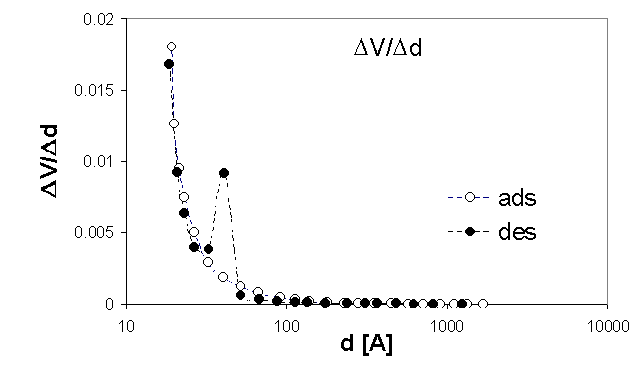
Adsorption/desorption isotherm of N2 on active carbon RIB (Norit), T=78K.
Differential mesopore size distribution DV/Dd (BJH method).
Differences betwee ads/des result from discrepancies between adsorbate structure and the model of open-ended cylindrical capillaries
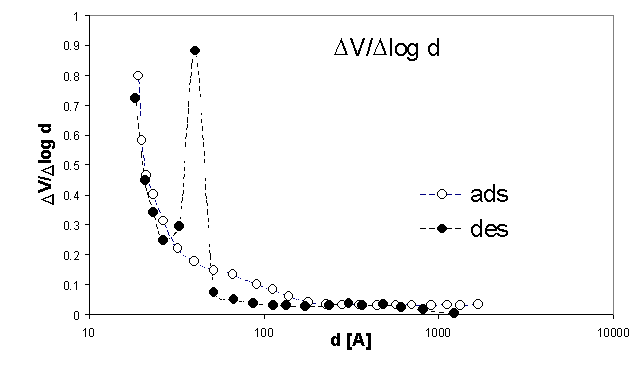
Adsorption/desorption isotherm of N2 on active carbon RIB (Norit), T=78K.
Differential logarytmic mesopore size distribution DV/Dlog10d (BJH method) (large pores are emphasized) Differences betwee ads/des result from discrepancies between adsorbate structure and the model of open-ended cylindrical capillaries
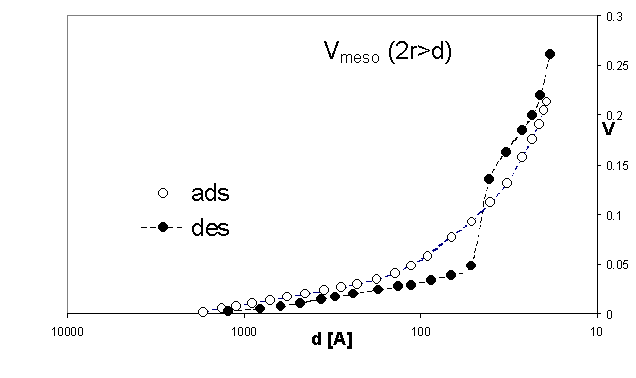
Adsorption/desorption isotherm of N2 on active carbon RIB (Norit), T=78K.
Cumulative distribution of of mesopore volume V(2r<d) (BJH method).
Differences betwee ads/des result from discrepancies between adsorbate structure and the model of open-ended cylindrical capillaries
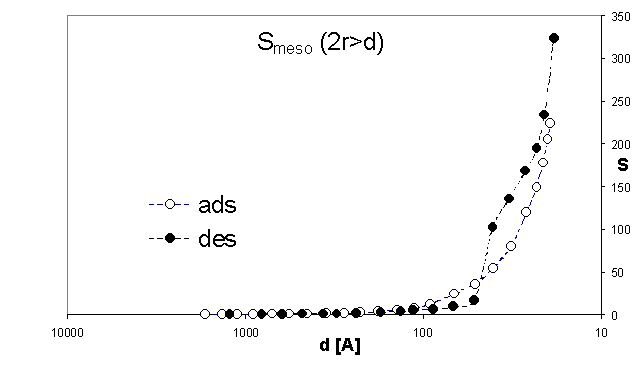
Adsorption/desorption isotherm of N2 on active carbon RIB (Norit), T=78K.
Cumulative distribution of of mesopore surface area Smeso(2r<d) (BJH method).
Differences betwee ads/des result from discrepancies between adsorbate structure and the model of open-ended cylindrical capillaries
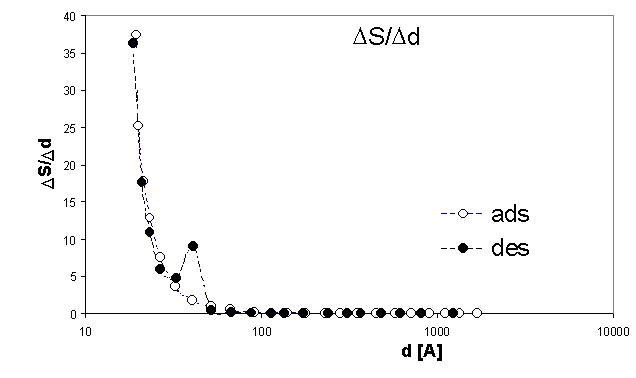
Adsorption/desorption isotherm of N2 on active carbon RIB (Norit), T=78K.
Differential distribution of mesopore surface area DS/Dd (BJH method).
Differences betwee ads/des result from discrepancies between adsorbate structure and the model of open-ended cylindrical capillaries
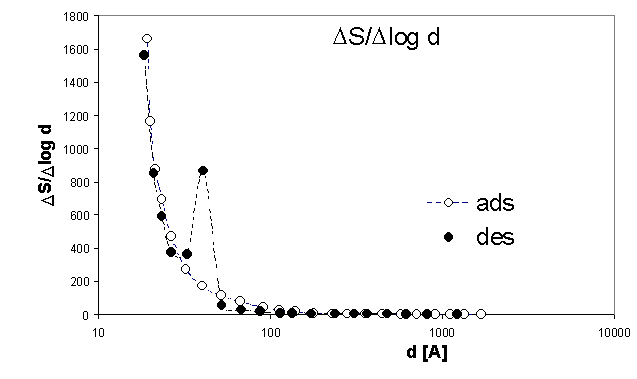
Adsorption/desorption isotherm of N2 on active carbon RIB (Norit), T=78K.
Differential logarithmic distribution of mesopore surface area DS/Dlog10d (BJH method) (large pores are emphasized). Differences betwee ads/des result from discrepancies between adsorbate structure and the model of open-ended cylindrical capillaries